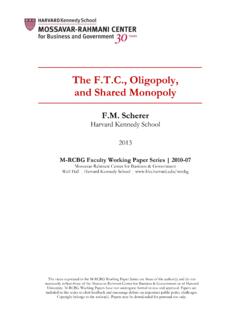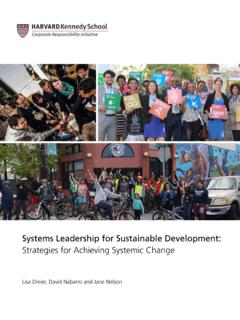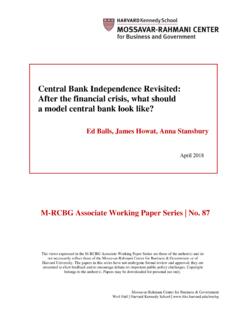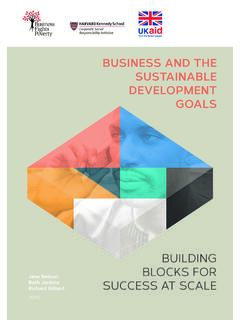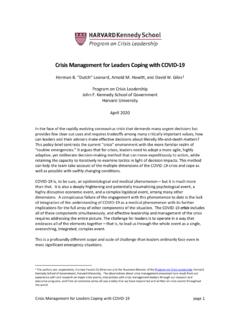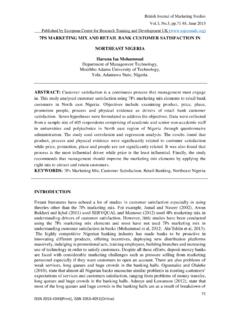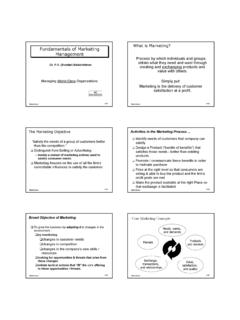Transcription of Are You Creating or Capturing Value? A dynamic framework ...
1 Are You Creating or Capturing value ? A dynamic framework for sustainable strategy Paul Verdin Koen Tackx January 2015. M-RCBG Associate Working Paper Series | No. 36. The views expressed in the M-RCBG Fellows and Graduate Student Research Paper Series are those of the author(s) and do not necessarily reflect those of the Mossavar-Rahmani Center for Business &. Government or of Harvard University. The papers in this series have not undergone formal review and approval; they are presented to elicit feedback and to encourage debate on important public policy challenges. Copyright belongs to the author(s). Papers may be downloaded for personal use only. Mossavar-Rahmani Center for Business & Government Weil Hall | Harvard Kennedy School | Are you Creating or Capturing value ?
2 A dynamic framework for sustainable strategy Paul Verdin Koen Tackx Solvay Brussels School Solvay Brussels School of Economics and Management, Belgium of Economics and Management Av. Franklin Roosevelt 42 CP114/01 B-1050 Av. Franklin Roosevelt 42 CP114/01 B-1050. Brussels Belgium Brussels Belgium + 32 495 22 88 22 +32 475 80 58 29. Mossavar-Rahmani Center for Business and Government, Harvard Kennedy School 79 J F Kennnedy Street Box 83 - Cambridge MA. 02138 - USA. + 1 617 495 8331. Useful comments and suggestions by Prof. R. Zeckhauser and Senior Fellows at the M-RCBG (Harvard Kennedy School) are hereby gratefully acknowledged. Any remaining errors or omissions are the authors' responsibility. 1. Introduction Is value the holy grail for every company?
3 Definitely it is something executives, investors and researchers are interested in since decades. If we only look at 4 major strategy journals over the last 20 years (Strategic Management Journal, California Management Review, Harvard Business Review and Sloan Management Review), together they published 189 articles with the word value in the title, meaning that on average about every month a new article was published focusing on the concept. Yet, value is perhaps one of the most used and misused terms in the history of management literature. To say the least, a lot of confusion persists not only about the meaning of the term, even more about ways to achieve it in a sustainable way. In this article, we start from a clear distinction between value creation and value Capturing and propose a simple and intuitive framework showing the critical role of managing the interaction and the dynamics between these two strategic imperatives for achieving sustainable success for any company.
4 We illustrate the framework with recent data from companies across a variety of industries providing further support for the relevance of the model. The value Creation value Capturing framework (VC2). We define value creation as the perceived benefit to the customer . This is in line with the microeconomic concept of the utility of a company's offering for its customers, whether it enhances the quality of life for a final consumer (B2C) or increases the profitability of a company (B2B). If a product or service is failing to do so, obviously there is no point in bringing it to the market after all. Offering a useful product or service alone is not sufficient. The pricing and cost 1. structures will have to accommodate sufficient value Capturing .
5 The provider has to generate sufficient revenue and profits for its shareholders. If the value created by a private enterprise is not sufficiently captured, there is no long term viability of the offering. Zooming in on the distinction and interaction of these two dimensions of value creation and value Capturing , leads us to the following dynamic model2 which is to be seen as a framework to help us understand the strategic challenge affecting a company's situation in a given market or industry. 2. Figure 1: The value Creation- value Capturing (VC2) framework . Waking up from the Dream Let us start in the dream situation (bottom right in Fig. 1) where well established companies generate substantial profits even if the value they create may be relatively limited or even shrinking.
6 This seems to hold for quite some companies with strong market positions or (quasi-) monopolies, such as was the case for many players in telecommunications, utilities or postal services before de-regulation and for the oil majors in the 1960'ies, IBM in the 1980'ies and Kodak or De Beers up to the 1990'ies. They all had been happily enjoying the benefits of their position, until anti-trust, de- regulation or new competitors showed up, putting pressures on prices and margins. The appearance and sudden growth of many newcomers, particularly those benefiting from technology and internet based opportunities, provide many more examples of nicely profitable businesses or industries under threat from creative newcomers, be it in the taxi-business, hotel industry, financial services or retail sector.
7 Pressures from (de)regulation or disruptive innovators invariably push established companies to the bottom left of figure 1 also known as hell . At first, the pressure will go unnoticed and companies tend to be blinded by denial: this won't happen to us ; it will last our while ; let's enjoy the good times while they last ;. business as usual or you don't understand, we are different! . However prices and 3. margins will be under pressure and provide a wake-up call, leading probably to some strategic reflection and reaction. In reality, however, inertia often takes over, and the tension between short term optimization and long-term strategic change often resolved to the benefit of the former. The eternal fear of cannibalization clearly fits into this mold.
8 Furthermore, a variety of stop-gap measures are at their disposal to try and avert or at least delay the immediate pressures, potentially aggravating the eventual crisis in the making. Such measures appear in different shapes and forms: price-fixing, colluding or forming cartels, smuggling in hidden price increases3 or just the opposite cutting prices in panic mode; cost-cutting and restructurings (without a cost-based strategy);. the usual suspects of cross-selling (even when the customer may not be interested in cross buying ), one stop shopping (even when the customer does not stop) or value added services (without any value added); targeting customer lock-in rather than Creating true loyalty based on superior customer value ; lobbying for more regulation.
9 And last but not least: mergers and acquisitions aimed at buying the competition rather than beating them (in the name of economies of scale, synergies or industry consolidation ) just to name a few (all variations on what we call playing the horizontal game , moving sideways in the lower part of the model). Sooner or later defensive measures may not suffice to avert the fate of customer , competitive or public pressures, pushing further towards the lower left corner: this is hell ! It is characterized by commoditization low value creation as well as low value Capturing (often referred to also as commodity hell , the commodity trap or the commodity magnet 4 ). This may be the plight or the final stage of companies in declining industries before they end up in bankruptcy ( American Airlines) or being taken over ( Nokia's handset business).
10 Climbing out of Hell The only way out of this situation is to start (re)focusing on Creating more customer value by making the offering more convincing towards customers. Such re-orientation requires climbing the wall of innovation, represented by an upward move along the vertical axis of our model, perhaps the most important strategic priority ever as stated for example by former CEO Samuel Palmisano from IBM: Either you innovate or you are in commodity hell .5. 4. Creating and innovating value to customers of course requires hard work and long-term investments. They are at the heart of strategic success, or at least the ultimate source or key driver of it. And, as recent studies have argued and illustrated, and some based on empirical evidence, there are only two ways to consistently add and create value successfully: either by becoming the low(est)-price champion (requiring continuous cost innovation) or by focusing on superior customer value (aiming for high price, requiring continuous value innovation)6.
